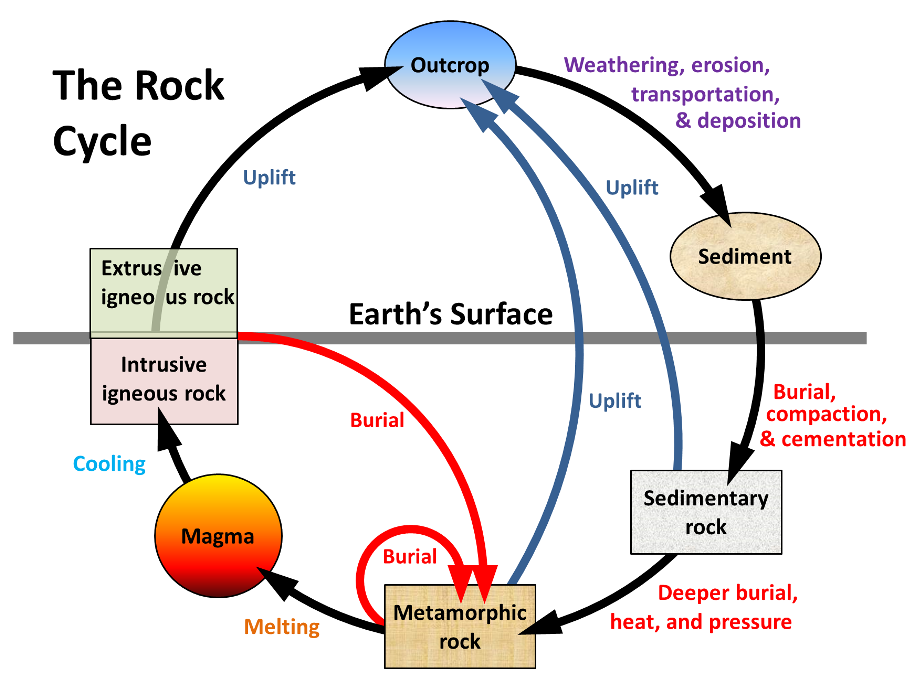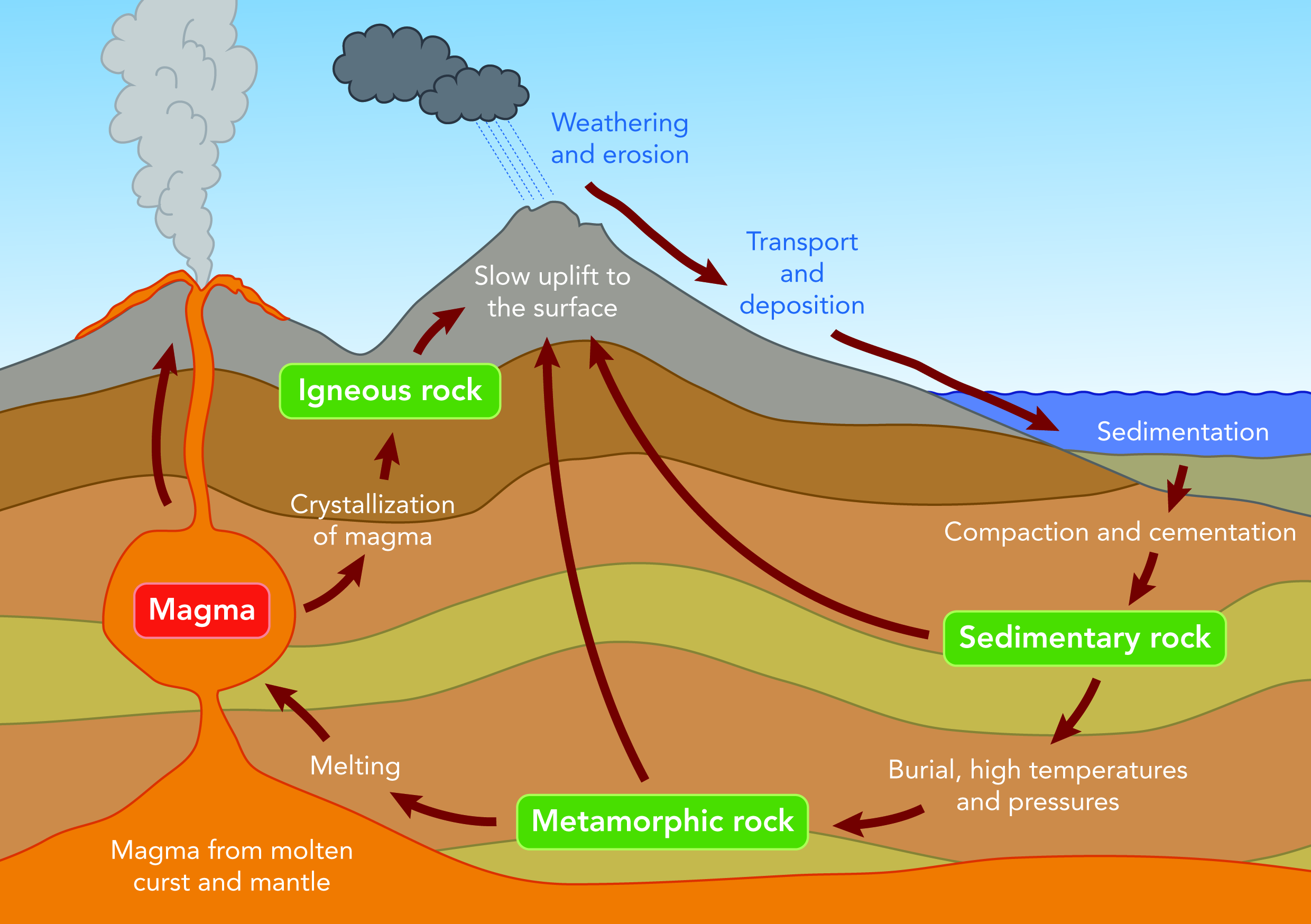Plate Boundaries That Best Describes the Rock Cycle
The Theory of Plate Tectonics is based on A evidence of sea floor spreading. Plate Tectonics Plate Boundaries and The Rock Cycle Fall 2017 Study Guide.

In What Way Is The Rock Cycle Intertwined With Plate Tectonics Lisbdnet Com
The rock cycle is a continuous cycle that runs continuously.

. 1 The rock cycle and Plate. Two plates move apart at a divergent plate boundary. A Layers of rock are broken by faults.
Start studying Plate Tectonics Earth Formation and Rock Cycle. The rock cycle and Plate tectonics are interconnected. B topographic mapping of mountain ranges.
The rock cycle is a series of processes on Earths surface and in the crust and mantle that slowly change rocks from one kind to anotherPlate movements start the rock cycle by helping to form. Rock material that forms where rocks are broken down into smaller pieces. Convergent plate boundariesInternal forces push two plates together.
All three types occur both in the ocean and on land. Which of the following terms best describes the rocky outer layer of the Earth. Learn vocabulary terms and more with flashcards games and other study tools.
Which type of plate boundary results from two or more plates coming together. The rock cycle and Plate tectonics. Plate TectonicsandThe Rock Cycle.
Plate Tectonics Plate Boundaries and The Rock Cycle Q A Question Answer IllustrationExample List the three main types of rocks and draw a picture of each. Molten rock that is stored underground. This hot magma flows out onto the ocean floor forming extrusive finely grained igneous rocks.
Three types of plate boundariesdivergent convergent and transform exist. Granite igneous rocks are extruded at volcanos caused by hot spots and convergent plate boundaries like subduction zones. The Rock Cycle and Plate Tectonics.
C an analysis of soil at the plate boundaries. At convergent plate boundaries sedimentary rock from the. The rock cycle concept was attributed to James Hutton.
The theory of plate tectonics has a very special relationship with the rock cycle. The crust the inner and outer mantle and the inner and outer core. Which of these statements BEST describes the rock cycle.
What are the 3 main types of rocks. Geologists use the term rock cycle to describe and simplify the complex interactions through which the three rock types can be linked to the processes that created them. Take a rock of your choice through the rock cycle describe how the rock is changed within the rock cycle and suggest the plate tectonic setting in which this change occurred.
The best way to explain the cycle is with the rock cycle diagram below and with examples of how each rock type can transform into another rock. Basalt an igneous rock flows to the surface at divergent boundaries such as mid ocean ridges and cracks in the earth caused by plate movements. B Rocks in the ocean become rocks on land.
What is the rock cycle. Play this game to review Science. Remember uplift and erosion have plate tectonic reasons for occurring.
1 The rock cycle and Plate tectonics are interconnected. All the changes that takes a place in the life of rocks come in the rock cycle. The rock cycle is a cycle that has no beginning and it also has no end.
Remember uplift and erosion have plate tectonic reasons for occurring. One version of the rock cycle is illustrated below. A process that changes one type of rock into another type of rock.
Metamorphic rocks are caused by heat and pressure. Granites and lava are emitted from volcanos usually form by the movement of plates at convergent boundaries. An area where two plates meeta plate boundary is a site of intense geologic activity Figure 122.
Take a rock of your choice through the rock cycle describe how the rock is changed within the rock cycle and suggest the plate tectonic setting in which this change occurred. Plate Tectonics and The Rock Cycle. At diverging plate boundaries convection currents bring hot magma to the surface.
Basaltic igneous rocks are extruded at mid ocean ridges caused by divergent boundaries. When the Earth was very young indeed it probably had a molten ocean of magma instead of a solid crust. Three types of plate boundariesDivergent plate boundariesPlates move apart from one another.
Plate Tectonics are key to the rock cycle forming igneous rocks and recycling sedimentary and metamorphic rocks. Describe the three types of plate boundaries. Schematic diagram of the rock cycle displaying the complex interactions between.
The rock cycle includes the movement transformation and movements of the rocks. This rock was formed by smaller pieces of rock that settled at the bottom of a lake millions of years ago. Igneous rocks are the basis of the rock cycle.
This allowed the separation of the various layers of the Earth. Transform faultsPlates slide and grind past one another along a fault line. Label the significant features.


No comments for "Plate Boundaries That Best Describes the Rock Cycle"
Post a Comment